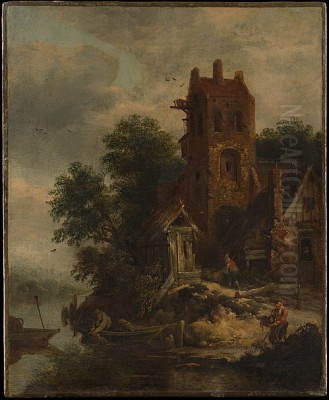
The Dutch Golden Age, spanning roughly the 17th century, was a period of extraordinary artistic flourishing in the Netherlands. Among the many talented painters who emerged during this era, landscape painting held a particularly prominent place, reflecting the nation's pride in its land and the burgeoning middle-class market for art. Roelof van Vries stands as a notable, albeit sometimes enigmatic, figure within this rich tradition, a painter celebrated for his evocative depictions of the Dutch rural environment. Active primarily in Haarlem and later Amsterdam, Van Vries captured the quiet beauty and rustic charm of village life, leaving behind a body of work that continues to engage viewers today.
A Life in the Golden Age
Pinpointing the exact details of Roelof van Vries's life presents certain challenges, a common issue with artists of this period for whom documentation can be scarce. He is generally believed to have been born around 1630 or 1631. His early life and artistic training remain largely obscure. We know he was active as a painter in Haarlem, a major center for landscape painting, during the mid-17th century. This city was home to some of the most influential landscape artists of the time, and their work undoubtedly shaped Van Vries's development.
Later in his career, Van Vries appears to have moved to Amsterdam, another vibrant hub of artistic and commercial activity. Records indicate his presence there, and it was in Amsterdam, in 1659, that he married Marytje Adriaens. The marriage document lists a certain Reynier Hens as a witness. That same year, 1659, he is also documented as becoming a member of the painters' Guild of Saint Luke in Leiden, suggesting connections or activity in that city as well, although Haarlem and Amsterdam seem to have been his primary bases.
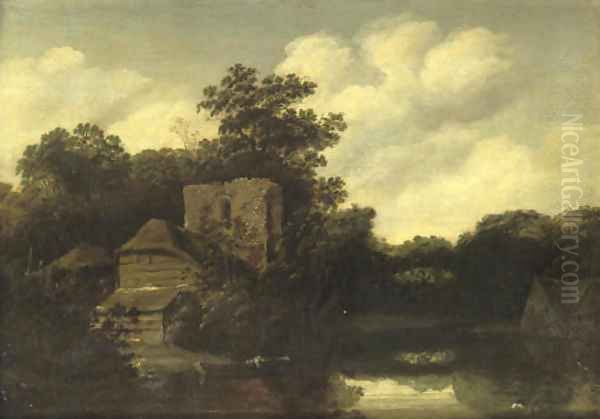
The end of his life is also marked by some uncertainty. The last known dated work signed by Van Vries is from 1681. While this year is often cited as his death year, there is no definitive record confirming this. It is possible he lived and perhaps continued to paint for some time after this date, but concrete evidence is lacking. This ambiguity contributes to the somewhat elusive nature of his biography.
Artistic Style and Dominant Influences
Roelof van Vries specialized almost exclusively in landscape painting. His works typically depict the Dutch countryside, focusing on rustic villages, dilapidated farm buildings, winding country roads, tranquil waterways, and wooded scenes. He had a keen eye for architectural detail, often including charmingly rendered cottages, barns, dovecotes, or the occasional crumbling tower or ruin, which added a picturesque element to his compositions. Trees are a frequent and dominant feature, often rendered with careful attention to their structure and foliage.
The staffage, or figures and animals, within his landscapes are usually small in scale but integral to the scene. Peasants are shown going about their daily lives – walking along paths, tending to animals, resting near cottages – adding a human dimension and narrative interest to the natural settings. These figures contribute to the overall atmosphere of peaceful, everyday rural existence that permeates much of his work.
Stylistically, Van Vries worked with a relatively fine brushstroke, allowing for considerable detail in his rendering of textures, foliage, and architectural elements. His palette is generally characterized by rich, often earthy tones, effectively capturing the specific light and atmosphere of the Dutch landscape. He demonstrated skill in depicting the interplay of light and shadow, contributing depth and realism to his scenes. The overall mood of his paintings is typically one of tranquility and quiet observation, celebrating the simple beauty of the countryside.
The most significant artistic influence on Roelof van Vries was undoubtedly Jacob van Ruisdael (c. 1628/29–1682), the preeminent landscape painter of the Dutch Golden Age, also active in Haarlem. The similarities in subject matter, composition, and mood between Van Vries's work and that of Ruisdael are often striking. Both artists favored wooded scenes, rustic buildings, and a certain melancholic or contemplative atmosphere. This strong connection has led some art historians to speculate that Van Vries may have been a direct pupil of Ruisdael, although definitive documentary proof for this relationship is missing. Regardless of direct tutelage, Ruisdael's impact on Van Vries's style is undeniable.
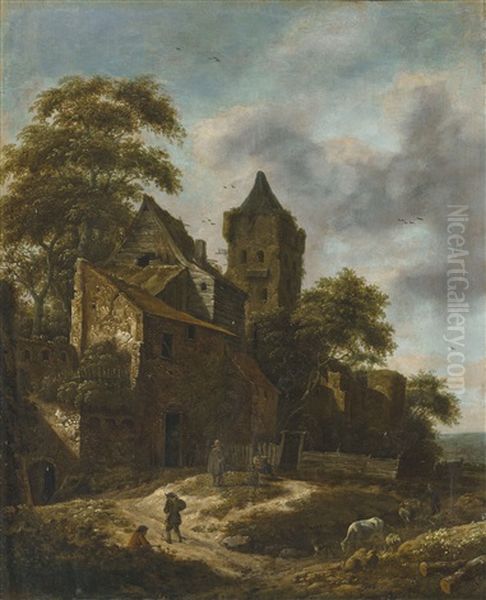
Other Haarlem contemporaries also likely played a role in shaping his artistic environment. The work of painters like Claes Molenaer (c. 1630–1676), known for his winter landscapes and village scenes, sometimes shares affinities with Van Vries's output. Indeed, the stylistic similarities have occasionally led to confusion in attributions between the two artists. The broader Haarlem school, with its emphasis on realistic depictions of the local landscape, provided the fertile ground from which Van Vries's art grew. Figures like Philips Wouwerman (1619–1668), though more famous for his scenes with horses, was another prominent Haarlem master whose landscape settings contributed to the artistic milieu.
Key Works and Recurring Themes
While perhaps not as widely known today as some of his contemporaries, Roelof van Vries produced a number of compelling works that exemplify his style and thematic concerns. One of his most recognized paintings is The Pigeon House (also known as The Dovecote), dated to the 1660s and now housed in the Metropolitan Museum of Art in New York. This work is a quintessential example of his art: it depicts a rustic, somewhat ramshackle farm building with a prominent dovecote, nestled amongst trees. Figures engage in quiet activity nearby, contributing to the scene's peaceful, everyday quality. The detailed rendering of the building, the textured foliage, and the soft, diffused light are characteristic of his approach.
Another work often cited is Landscape with a Tower. While specific versions may vary, paintings with this theme typically feature a prominent, often partially ruined, tower integrated into a rural landscape. These structures add a touch of romanticism and historical depth to the scenes, a common motif in Dutch landscape painting of the period, perhaps reflecting a fascination with the past or the transience of human endeavors compared to nature.
Paintings titled Dune Landscape with Figures and Farmstead also appear in his oeuvre. These works capture the specific topography of the coastal regions of the Netherlands, often featuring sandy tracks, sparse vegetation, and simple dwellings set against expansive skies. One such painting, noted as having been in the collection of Walther Bernt in Munich in 1959, later appeared on the art market, showcasing his ability to render this distinct type of Dutch terrain.
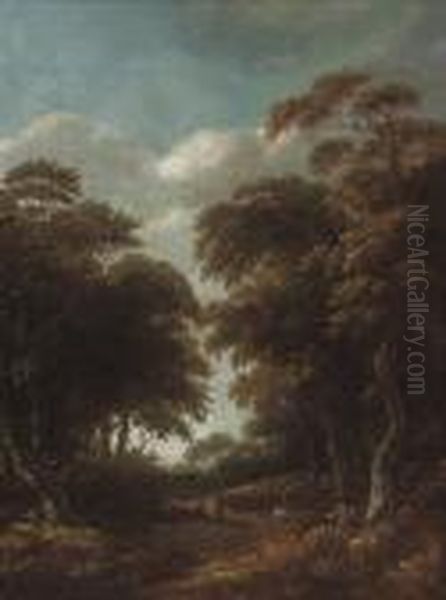
Works described simply as Dutch Landscape or with titles like Hollandse Bouwen op de Weg (roughly translating to Dutch Country Folk on the Road) further underscore his consistent focus on the local environment and its inhabitants. Across these works, the recurring themes are clear: the quiet dignity of rural life, the intricate beauty of the natural world (particularly trees and foliage), the charm of vernacular architecture, and an overall atmosphere of serenity. He was not typically a painter of dramatic events or grand vistas, but rather found his niche in the intimate and closely observed corners of the Dutch countryside.
Contemporaries and the Haarlem Milieu
Roelof van Vries operated within a vibrant and competitive artistic community, particularly during his time in Haarlem. His work should be understood in the context of the numerous other landscape painters active during the Dutch Golden Age. As mentioned, Jacob van Ruisdael was the towering figure whose influence is most apparent in Van Vries's work. Ruisdael's own nephew, Salomon van Ruysdael (1600/03–1670), was another major Haarlem landscape painter, known for his river scenes and tonal atmospheric effects, representing an earlier phase of the Haarlem school.
Meindert Hobbema (1638–1709), Jacob van Ruisdael's most famous pupil, developed a style focused on sunnier, more idyllic woodland scenes, often featuring watermills. While distinct, Hobbema's work shares the detailed observation of nature found in both Ruisdael and Van Vries. Cornelis Decker (active c. 1640–1678), another Haarlem artist, specialized in landscapes often featuring weavers' cottages and wooded surroundings, and his style sometimes bears comparison to Van Vries's architectural depictions.
Jan Wijnants (c. 1632–1684), active in both Haarlem and later Amsterdam, was known for his Italianate-influenced dune landscapes and country roads, often featuring distinctive, gnarled trees. Some sources suggest potential collaborations or close associations between Van Vries and Wijnants, perhaps with one artist painting the landscape and another adding figures, a common practice at the time, though concrete evidence for specific joint works can be hard to establish. Similarly, his connection with Claes Molenaer points to the close-knit nature of the Haarlem artistic community, where styles could influence each other and attributions could become complex.
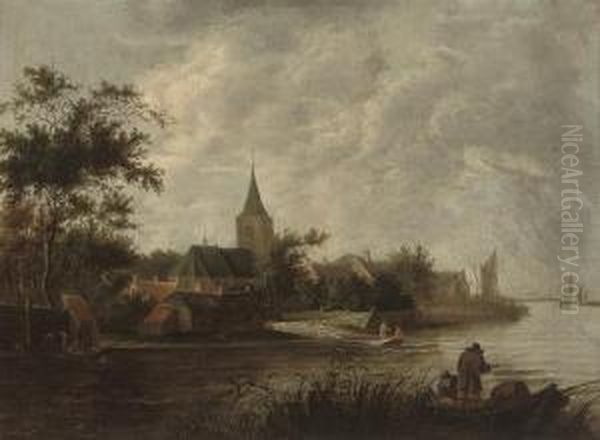
Other prominent Dutch landscape painters of the era, while perhaps not directly linked to Van Vries, formed the broader backdrop against which he worked. Jan van Goyen (1596–1656) was a pioneer of the "tonal phase" of Dutch landscape painting, known for his near-monochromatic palette and atmospheric effects. Aelbert Cuyp (1620–1691), based in Dordrecht, became famous for his depictions of the Dutch landscape bathed in a warm, golden, almost Italianate light. Allaert van Everdingen (1621–1675) introduced dramatic Scandinavian-inspired landscapes with waterfalls and pine forests to the Dutch repertoire after traveling to Norway and Sweden. Even Philips Wouwerman, primarily a painter of horses and battle scenes, set his subjects within meticulously rendered landscapes that contributed to the high standard of landscape art in Haarlem. This rich tapestry of artists underscores the specialization and innovation occurring in Dutch landscape painting during Van Vries's lifetime.
Identity, Attribution, and Historical Standing
One of the persistent issues surrounding Roelof van Vries is the ambiguity concerning his name and signature, which has complicated his art historical profile. He is sometimes referred to or confused with a "Roelandt van Vries." While most scholars now consider Roelof and Roelandt to be the same person, the variation in historical records and potential signature forms (including perhaps "Roelof Jansz," suggesting his father's name was Jan) has created uncertainty.
Furthermore, Van Vries's signature itself has reportedly been altered or removed from some of his paintings in the past, occasionally being replaced with the more famous signature of Jacob van Ruisdael to increase a work's market value. This practice, unfortunately not uncommon in art history, has made definitive attribution challenging. His stylistic proximity to Ruisdael, as well as to other contemporaries like Claes Molenaer, further muddies the waters. Consequently, works genuinely by Van Vries may have been misattributed to others, and vice versa.
This confusion has likely impacted his overall historical reputation. While recognized by specialists as a skilled painter within the Haarlem tradition, he has not achieved the same level of name recognition as Ruisdael or Hobbema. His status as a highly competent follower or imitator of Ruisdael, combined with the attribution difficulties, has perhaps prevented him from being consistently evaluated entirely on his own merits. Despite these challenges, the quality of his securely attributed works speaks to his considerable talent.
Legacy and Collections
Despite the biographical and attributional complexities, Roelof van Vries holds a secure place as a representative painter of the Dutch Golden Age landscape tradition. His works capture a specific vision of the 17th-century Dutch countryside, emphasizing its rustic charm and tranquil atmosphere. His paintings were appreciated during his time and continue to find favor among collectors and museum audiences who value the detailed realism and peaceful mood characteristic of this genre.
His works appear periodically on the art market, often commanding respectable prices, indicating a continued appreciation for his skill. As noted, auction results have seen his paintings sell for several thousand dollars, reflecting their desirability.
Examples of Roelof van Vries's work can be found in public and private collections. The Metropolitan Museum of Art in New York holds the well-known The Pigeon House. Other works reside in various European museums and numerous private collections. Provenance records, like the mention of the Walther Bernt collection for a dune landscape, help trace the history of individual pieces. Auction houses like Fontaine's Auction Gallery and others continue to handle his works, making them accessible, albeit intermittently, to new generations of collectors and scholars.
Conclusion: A Quiet Vision of Holland
Roelof van Vries remains a figure of interest within the extensive field of Dutch Golden Age landscape painting. Though perhaps overshadowed by the giants of the era like Jacob van Ruisdael, and complicated by issues of identity and attribution, his contribution is significant. He was a highly skilled painter who excelled at capturing the intimate, rustic beauty of the Dutch countryside. His detailed renderings of village scenes, woodland paths, and humble dwellings, populated by quietly industrious figures, offer a valuable and evocative glimpse into the world of 17th-century Holland. His paintings stand as testaments to the era's deep appreciation for the local landscape and the enduring appeal of scenes depicting peace, nature, and the rhythms of everyday life. While mysteries about his life and the full extent of his oeuvre may remain, the works attributed to Roelof van Vries continue to resonate with their quiet charm and accomplished artistry.